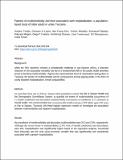| dc.description.abstract | Background
while the HIV epidemic remains a considerable challenge in sub-Saharan Africa, a dramatic reduction in the associated mortality has led to a fundamental shift in the public health priorities aimed at tackling multimorbidity. Against the unprecedented level of urbanisation taking place in Tanzania, the burden of multimorbidity and its consequences among ageing adults, in the form of costly inpatient hospitalisation, remain unquantified.
Methods
we used data from one of Africa’s largest urban population cohort, the Dar es Salaam Health and the Demographic Surveillance System, to quantity the extent of multimorbidity (occurrence of 2 ≥ health conditions) and discordant multimorbidity (occurrence of conditions in 2 ≥ domains in mental health, non-communicable and communicable health) among 2,299 adults aged ≥40 years in Dar es Salaam, Tanzania. We fitted logistic regression models to investigate the association between multimorbidity and inpatient hospitalisation.
Results
the prevalence of multimorbidity and discordant multimorbidity were 25.3 and 2.5%, respectively. Although the severe forms of multimorbidity (2.0% with ≥4 health conditions) and discordancy were low, hospitalisation was significantly higher based on the regression analyses. Household food insecurity was the only socio-economic variable that was significantly and consistently associated with a greater hospitalisation.
Conclusion
we found an alarmingly high degree of multimorbidity among this ageing urban population where hospitalisation was driven by multimorbidity. As public health resources remain scarce, reducing costly inpatient hospitalisation requires multilevel interventions that address clinical- and structural-level challenges (e.g. food insecurity) to mitigate multimorbidity and promote long-term healthy independent living among older adults in Tanzania. | en_US |

